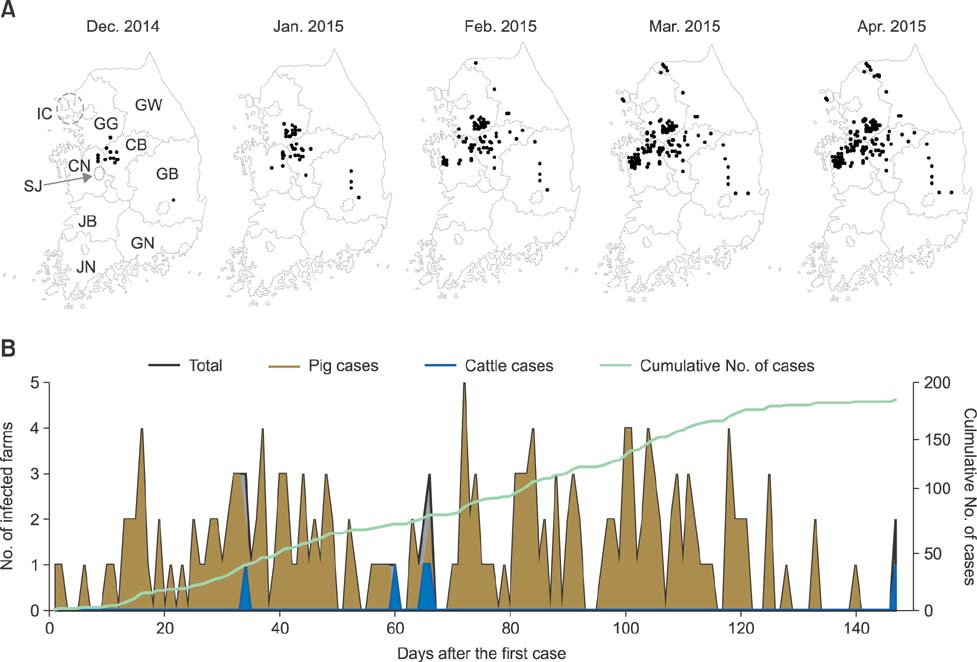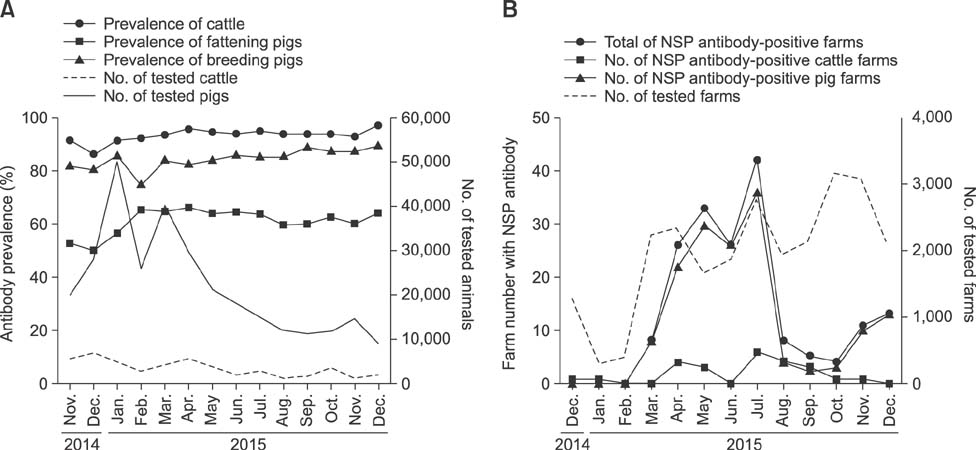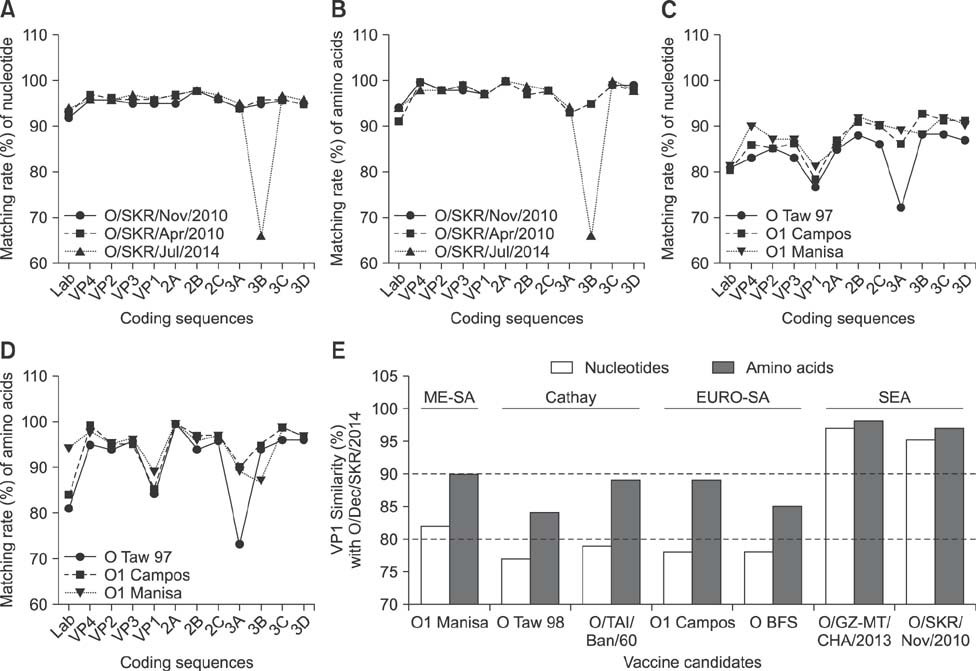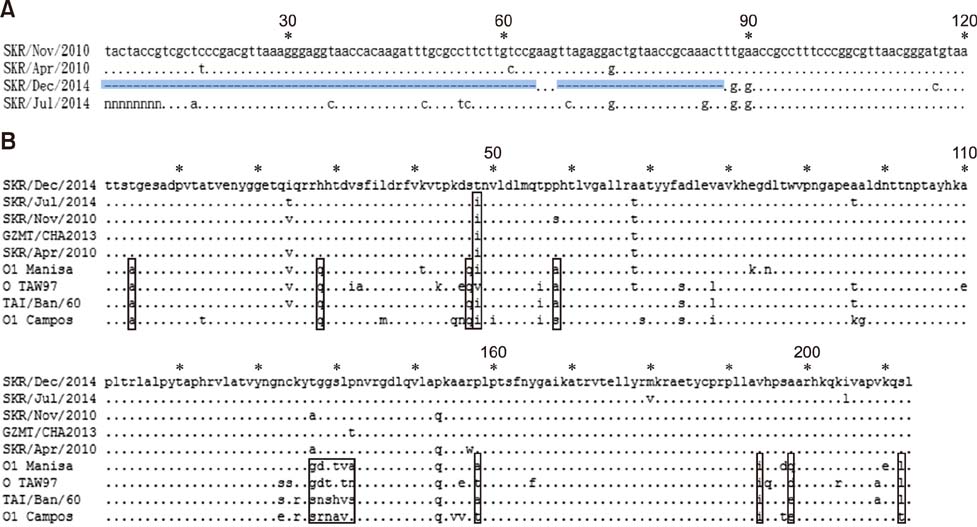J Vet Sci.
2018 Mar;19(2):271-279. 10.4142/jvs.2018.19.2.271.
Control of type O foot-and-mouth disease by vaccination in Korea, 2014–2015
- Affiliations
-
- 1Animal and Plant Quarantine Agency, Gimcheon 39660, Korea. parkjhvet@korea.kr
- 2Korea Zoonosis Research Institute, Chonbuk National University, Iksan 54531, Korea.
- KMID: 2407626
- DOI: http://doi.org/10.4142/jvs.2018.19.2.271
Abstract
- On December 3, 2014, a type O foot-and-mouth disease (FMD) outbreak began in Korea. Although vaccinations were administered, FMD cases increased steadily for five months, and reached 185 cases by April 2015. Most of the affected animals were pigs, which are vulnerable to vaccination. The FMD virus belonged to the South-East Asia (SEA) topotype that had been observed three times in Korea between April 2010 and July 2014. However, the FMD virus isolated in December 2014 had a unique feature; that is, partial deletion of the 5"² non-coding region, a deletion not seen in previous SEA topotype isolates identified in Korea. We conclude that this outbreak included the introduction of a new FMD strain to Korea, and that Korea was now affected by genetically similar FMD virus strains that are related to those from neighboring countries.
Keyword
Figure
Cited by 2 articles
-
Needleless intradermal vaccination for foot-and-mouth disease induced granuloma-free effective protection in pigs
Ji-Hyeon Hwang, Kwang-Nyeong Lee, Su-Mi Kim, Gyeongmin Lee, Yoonjung Moon, Byounghan Kim, Jong-Soo Lee, Jong-Hyeon Park
J Vet Sci. 2019;20(3):. doi: 10.4142/jvs.2019.20.e29.New foot-and-mouth disease vaccine, O JC-R, induce complete protection to pigs against SEA topotype viruses occurred in South Korea, 2014–2015
Hye-Eun Jo, Mi-Kyeong Ko, Joo-Hyung Choi, Sung Ho Shin, Hyundong Jo, Su-Hwa You, Min Ja Lee, Su-Mi Kim, Byounghan Kim, Jong-Hyeon Park
J Vet Sci. 2019;20(4):. doi: 10.4142/jvs.2019.20.e42.
Reference
-
1. Abdela N. Sero-prevalence, risk factors and distribution of foot and mouth disease in Ethiopia. Acta Trop. 2017; 169:125–132.
Article2. Brito BP, Rodriguez LL, Hammond JM, Pinto J, Perez AM. Review of the global distribution of foot-and-mouth disease virus from 2007 to 2014. Transbound Emerg Dis. 2017; 64:316–332.
Article3. Cai C, Li H, Edwards J, Hawkins C, Robertson ID. Meta-analysis on the efficacy of routine vaccination against foot and mouth disease (FMD) in China. Prev Vet Med. 2014; 115:94–100.
Article4. Hall TA. BioEdit: a user-friendly biological sequence alignment editor and analysis program for Windows 95/98/NT. Nucl Acids Symp Ser. 1999; 41:95–98.5. Kitching RP. Clinical variation in foot and mouth disease: cattle. Rev Sci Tech. 2002; 21:499–504.
Article6. Kitching RP, Alexandersen S. Clinical variation in foot and mouth disease: pigs. Rev Sci Tech. 2002; 21:513–518.
Article7. Knowles NJ, He J, Shang Y, Wadsworth J, Valdazo-González B, Onosato H, Fukai K, Morioka K, Yoshida K, Cho IS, Kim SM, Park JH, Lee KN, Luk G, Borisov V, Scherbakov A, Timina A, Bold D, Nguyen T, Paton DJ, Hammond JM, Liu X, King DP. Southeast Asian foot-and-mouth disease viruses in Eastern Asia. Emerg Infect Dis. 2012; 18:499–501.
Article8. Park JH, Lee KN, Kim SM, Lee HS, Ko YJ, Tark DS, Shin YK, Seo MG, Kim B. Reemergence of foot-and-mouth disease, South Korea, 2000–2011. Emerg Infect Dis. 2014; 20:2158–2161.
Article9. Park JH, Lee KN, Ko YJ, Kim SM, Lee HS, Park JY, Yeh JY, Kim MJ, Lee YH, Sohn HJ, Cho IS, Kim B. Diagnosis and control measures of the 2010 outbreak of foot-and-mouth disease A type in the Republic of Korea. Transbound Emerg Dis. 2013; 60:188–192.
Article10. Park JH, Lee KN, Ko YJ, Kim SM, Lee HS, Shin YK, Sohn HJ, Park JY, Yeh JY, Lee YH, Kim MJ, Joo YS, Yoon H, Yoon SS, Cho IS, Kim B. Control of foot-and-mouth disease during 2010–2011 epidemic, South Korea. Emerg Infect Dis. 2013; 19:655–659.
Article11. Park JH, Tark D, Lee KN, Lee SY, Ko MK, Lee HS, Kim SM, Ko YJ, Seo MG, Chun JE, Lee MH, Kim B. Novel foot-and-mouth disease virus in Korea, July–August 2014. Clin Exp Vaccine Res. 2016; 5:83–87.
Article12. Tamura K, Stecher G, Peterson D, Filipski A, Kumar S. MEGA6: Molecular Evolutionary Genetics Analysis version 6.0. Mol Biol Evol. 2013; 30:2725–2729.
Article13. Wada M, Stevenson M, Cogger N, Carpenter T. Evaluation of the control strategy for the 2010 foot-and-mouth disease outbreak in Japan using disease simulation. Transbound Emerg Dis. 2017; 64:978–989.
Article
- Full Text Links
- Actions
-
Cited
- CITED
-
- Close
- Share
- Similar articles
-
- Novel foot-and-mouth disease virus in Korea, July-August 2014
- New foot-and-mouth disease vaccine, O JC-R, induce complete protection to pigs against SEA topotype viruses occurred in South Korea, 2014–2015
- Association of the time that elapsed from last vaccination with protective effectiveness against foot-and-mouth disease in small ruminants
- Dietary germanium biotite supplementation enhances the induction of antibody responses to foot-and-mouth disease virus vaccine in pigs
- Genetic identification and serological evaluation of commercial inactivated foot-and-mouth disease virus vaccine in pigs






